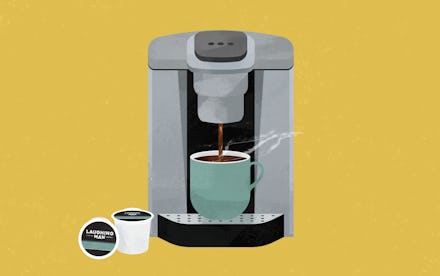Mornings can be tough, especially for those of us who identify more as night owls. It’s that first step – getting up – which can seem so insurmountable. If you feel like you’re alone in this, you’re not. According to a 2018 Reuters study, about 64 percent of Americans drank a cup of coffee every single day in 2017, and that number continues to climb. And while every coffee aficionado knows the warm, familiar embrace of a good mug in the morning (not to mention the afternoon and evening, if we’re being honest), chances are most of them don’t know about the journey that coffee took before fueling their days.
Keurig’s single-serving brewing method makes brewing easy, but the process of creating these K-Cup® pods involves a whole lot of science – and compassion. Laughing Man® Coffee, specifically, relies on a cycle of positivity, putting into practice the mission to make every cup count. Laughing Man® Coffee prioritizes giving back to the farming communities who provide their coffee. A portion of proceeds from every pack or bag sold goes to the Laughing Man Foundation, an organization the company’s founders created to strengthen coffee farming communities, including programs to support the health and growth of both the farmers themselves as well as their families. The foundation also allocates funds to power community-based programs spanning education, infrastructure, and housing in addition to the farmers’ Fair Trade premiums. So when you enjoy a cup of exceptional Laughing Man® Coffee, you directly support the individuals who grew the beans making up the backbone of your beverage.
While everyone knows about that euphoric first sip of joe that sparks their morning, most have no idea how it ended up in their local supermarket. To help paint a picture for the uninformed, the team at Mic followed the process to make Laughing Man® Coffee, from perennial bloom to your morning savior.
It all starts with a cherry
A perennial evergreen blooms with saccharine blossoms that eventually turn into brightly-colored cherries. These red fruits contain two seeds—the coffee beans.
Ripe cherries are left to dry
As cherries mature, their hues progress to deeper crimson tones, marking ripeness. From there, whole cherries luxuriate in the sunshine for several weeks to dry out. This process helps facilitate flavor and fragrance development. Ethiopian coffee — the only country in which coffee grows wild — tends to boast a full-bodied, strong flavor profile balancing fruit and florals. Colombian coffee typically falls on the milder side, with hints of nuttiness alongside a slightly sweeter, less acidic taste.
Dry cherries are hand-picked
While other coffee brands may rely on machines for harvesting, Laughing Man® Coffee is harvested by farmers, who hand-pick these fruits to process.
Then pulped
The fruit’s skin is then removed in a process called pulping.
Fermentation begins
Next, the cherries ferment in water for a few days. This soaking method helps break down what’s left of the outer fruity flesh ensconcing the beans.
It all goes to the roaster
Green coffee beans then go into the roaster, where they establish the rich mahogany tones we associate with a killer cup of joe.
Specific grinding
K-Cup® pods contain ground coffee, but the grinding process those beans undergo differs from bags of ground coffee you may find in a cafe or grocery store. Assuming the coarse grind of coffee brewed in a French press is one end of the grind spectrum and the fine, almost powdery grind popular with espresso blends is the other, the grind used for K-Cup® pods sits smack-dab in the middle with a very even grind akin to the table sugar you may add to your own cup.
Measured to perfection
Exact measurements determine how much grounds make it into each recyclable, Laughing Man® Coffee K-Cup® pod before a printed foil label seals it up.
Packaged to move
Conveyor belts move K-Cup® pods into packaging. Once the boxes are labeled and stacked, they are distributed to retailers where people can purchase them and conveniently brew excellent coffee at home or work.
Although K-Cup® pods brew and pour into your trusty mug like magic, the reality of its journey might be something even more special — rooted in the coffee plants’ farms and farmer communities. What you taste is delicious, sure, but also contains a whole lot of heart. And that’s something we can all toast to.
Learn more at LaughingManCoffee.com.
This article is sponsored by Laughing Man® Coffee.
